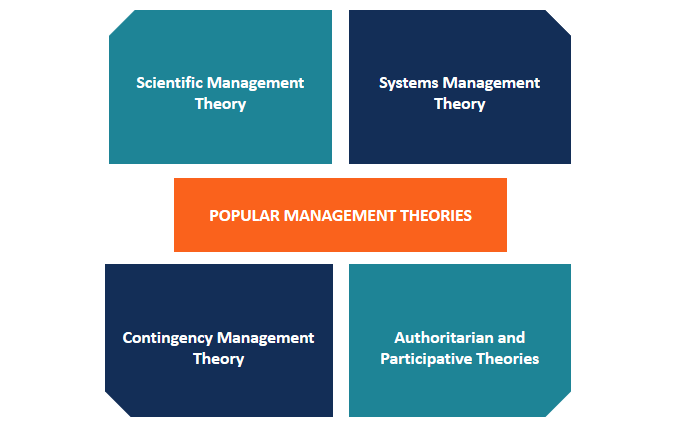Thủ Thuật Hướng dẫn Which perspective suggests that universal theories Cannot be applied to organizations because each organization is unique? Mới Nhất
Quý khách đang tìm kiếm từ khóa Which perspective suggests that universal theories Cannot be applied to organizations because each organization is unique? được Update vào lúc : 2022-10-07 04:05:29 . Với phương châm chia sẻ Bí kíp về trong nội dung bài viết một cách Chi Tiết Mới Nhất. Nếu sau khi Read tài liệu vẫn ko hiểu thì hoàn toàn có thể lại Comment ở cuối bài để Ad lý giải và hướng dẫn lại nha.Concepts surrounding recommended management strategies
Nội dung chính- What are Management Theories?
- At a Glance
- Popular Management Theories
- Why Study Management Theories?
- Key Takeaway
- Additional Resources
- Which management perspective states that there is not one best way of doing things and that solutions must be developed based on the relevant circumstances?
- In what way is the contingency perspective different than universal perspectives quizlet?
- What are the 5 management theories?
- What is generally true about management theories that are used to build organizations and guide them to their goals quizlet?
What are Management Theories?
Management theories are concepts surrounding recommended management strategies, which may include tools such as frameworks and guidelines that can be implemented in modern organizations. Generally, professionals will not rely solely on one management theory alone, but instead, introduce several concepts from different management theories that best suit their workforce and company culture.

At a Glance
Until the day that machines are able to think, talk, and experience emotions, humans will remain the most complicated beings to manage. Humans can never achieve the kind of error-không lấy phí performance that machines provide. On the upside, there are tons of things that machines aren’t capable of doing, making humans indispensable assets. For such reason, proper management is one of the most crucial things for an organization.
For a long time, theorists have been researching the most suitable forms of management for different work settings. This is where management theories come into play. Although some of these theories were developed centuries ago, they still provide stable frameworks for running businesses.
Popular Management Theories
1. Scientific Management TheoryAmerican mechanical engineer Frederick Taylor, who was one of the earliest management theorists, pioneered the scientific management theory. He and his associates were among the first individuals to study work performance scientifically. Taylor’s philosophy emphasized the fact that forcing people to work hard wasn’t the best way to optimize results. Instead, Taylor recommended simplifying tasks so as to increase productivity.
The strategy was a bit different from how businesses were conducted beforehand. Initially, a factory executive enjoyed minimal, if any, contact with his employees. There was absolutely no way of standardizing workplace rules and the only motivation of the employees was job security.
According to Taylor, money was the key incentive for working, which is why he developed the “fair day’s wages for a fair day’s work” concept. Since then, the scientific management theory has been practiced worldwide. The resulting collaboration between employees and employers evolved into the teamwork that people now enjoy.
2. Systems Management TheorySystems management offers an alternative approach to the planning and management of organizations. The systems management theory proposes that businesses, like the human body toàn thân, consists of multiple components that work harmoniously so that the larger system can function optimally. According to the theory, the success of an organization depends on several key elements: synergy, interdependence, and interrelations between various subsystems.
Employees are one of the most important components of a company. Other elements crucial to the success of a business are departments, workgroups, and business units. In practice, managers are required to evaluate patterns and events in their companies so as to determine the best management approach. This way, they are able to collaborate on different programs so that they can work as a collective whole rather than as isolated units.
3. Contingency Management TheoryThe main concept behind the contingency management theory is that no one management approach suits every organization. There are several external and internal factors that will ultimately affect the chosen management approach. The contingency theory identifies three variables that are likely to influence an organization’s structure: the size of an organization, technology being employed, and style of leadership.
Fred Fiedler is the theorist behind the contingency management theory. Fiedler proposed that the traits of a leader were directly related to how effectively he led. According to Fiedler’s theory, there’s a set of leadership traits handy for every kind of situation. It means that a leader must be flexible enough to adapt to the changing environment. The contingency management theory can be summed up as follows:
- There is no one specific technique for managing an organization.
- A leader should be quick to identify the particular management style suitable for a particular situation.
- The primary component of Fiedler’s contingency theory is LPC – the least preferred co-worker scale. LPC is used to assess how well oriented a manager is.
Do you believe that every individual gets maximum satisfaction from the work they do? Or are you of the opinion that some view work as a burden and only do it for the money? Such assumptions influence how an organization is run. The assumptions also form the basis of Theory X and Theory Y.
Douglas McGregor is the theorist credited with developing these two contrasting concepts. More specifically, these theories refer to two management styles: the authoritarian (Theory X) and participative (Theory Y).
In an organization where team members show little passion for their work, leaders are likely to employ the authoritarian style of management. But if employees demonstrate a willingness to learn and are enthusiastic about what they do, their leader is likely to use participative management. The management style that a manager adopts will influence just how well he can keep his team members motivated.
Theory X holds a pessimistic view of employees in the sense that they cannot work in the absence of incentives. Theory Y, on the other hand, holds an optimistic opinion of employees. The latter theory proposes that employees and managers can achieve a collaborative and trust-based relationship.
Still, there are a couple of instances where Theory X can be applied. For instance, large corporations that hire thousands of employees for routine work may find adopting this form of management ideal.

Why Study Management Theories?
1. Increasing ProductivityOne of the reasons why managers should be interested in learning management theories is because it helps in maximizing their productivity. Ideally, the theories teach leaders how to make the most of the human assets their disposal. So, rather than purchase new equipment or invest in a new marketing strategy, business owners need to invest in their employees through training.
It can be seen in Taylor’s scientific management theory. As mentioned earlier, Taylor proposed that the best way to boost workers’ productivity was by first observing their work processes and then creating the best policies.
2. Simplifying Decision MakingAnother area where management theories have proven to be useful is in the decision-making process. Max Weber proposed that hierarchical systems encourage informed decision-making. A report written by the Institute for Employment Studies suggests that flattening the hierarchy paves the way for local innovation while speeding up the decision-making process. Flattening out entails getting rid of job titles and senior positions so as to inspire a cohesive work environment.
3. Encouraging Staff ParticipationManagement theories developed in the 1900s, aimed encouraging interpersonal relationships in the workplace. One such theory that encouraged a collaborative environment is the human relations approach. According to this theory, business owners needed to give their employees more power in making decisions.
Key Takeaway
Throughout history, companies have been putting different management theories into practice. Not only have they helped to increase productivity but they have also improved the quality of services. Although these management theories were developed ages ago, they help in creating interconnected work environments where employees and employers work hand-in-hand. Some of the most popular management theories that are applied nowadays are systems theory, contingency theory, Theory X and Theory Y, and the scientific management theory.
Additional Resources
Thank you for reading CFI’s guide to management theories. To learn more and expand your career, explore the additional relevant resources below:
- Employee Morale
- Impostor Syndrome
- Leadership Theories
- Management Skills
Which management perspective states that there is not one best way of doing things and that solutions must be developed based on the relevant circumstances?
Contingency Theory is a unique approach to leadership The basic premise of Contingency Theory is that there is no one best way to lead an organization. The basic premise of Contingency Theory is that there is no one best way to lead an organization.In what way is the contingency perspective different than universal perspectives quizlet?
The contingency perspective, in contrast, suggests that universal theories cannot be applied to organizations because each organization is unique. Instead, the contingency perspective suggests that appropriate managerial behavior in a given situation depends on, or is contingent on, unique elements in that situation.What are the 5 management theories?
The five functions of management as defined by Henri Fayol are: Planning, Organizing, Command, Coordination, and Control. These five functions comprise “management”, one of the six industrial activities described in Henri Fayol management theory. Henri Fayol is widely regarded as the father of modern management.What is generally true about management theories that are used to build organizations and guide them to their goals quizlet?
What is generally true about management theories that are used to build organizations and guide them to their goals? They are simple. They are abstract. They are scientific in nature. Tải thêm tài liệu liên quan đến nội dung bài viết Which perspective suggests that universal theories Cannot be applied to organizations because each organization is unique? Reply
Reply
 7
7
 0
0
 Chia sẻ
Chia sẻ
Chia Sẻ Link Download Which perspective suggests that universal theories Cannot be applied to organizations because each organization is unique? miễn phí
Bạn vừa đọc nội dung bài viết Với Một số hướng dẫn một cách rõ ràng hơn về Video Which perspective suggests that universal theories Cannot be applied to organizations because each organization is unique? tiên tiến và phát triển nhất và Chia Sẻ Link Down Which perspective suggests that universal theories Cannot be applied to organizations because each organization is unique? Free.